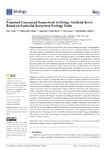Mostrar o rexistro simple do ítem
Proposed Conceptual Framework to Design Artificial Reefs Based on Particular Ecosystem Ecology Traits
| dc.contributor.author | Carral Couce, Luis | |
| dc.contributor.author | Lamas, M.I. | |
| dc.contributor.author | Cartelle Barros, Juan José | |
| dc.contributor.author | López, I. | |
| dc.contributor.author | Carballo, Rodrigo | |
| dc.date.accessioned | 2022-06-14T14:46:53Z | |
| dc.date.available | 2022-06-14T14:46:53Z | |
| dc.date.issued | 2022-04-28 | |
| dc.identifier.citation | Carral, L.; Lamas, M.I.; Cartelle Barros, J.J.; López, I.; Carballo, R. Proposed Conceptual Framework to Design Artificial Reefs Based on Particular Ecosystem Ecology Traits. Biology 2022, 11, 680. https://doi.org/10.3390/biology11050680 | es_ES |
| dc.identifier.issn | 2079-7737 | |
| dc.identifier.uri | http://hdl.handle.net/2183/30929 | |
| dc.description.abstract | [Abstract] Overfishing and pollution have led to marine habitat degradation, and as a result, marine fisheries are now in decline. Consequently, there is a real need to enhance marine ecosystems while halting the decline of fish stocks and boosting artisanal fishing. Under these circumstances, artificial reefs (ARs) have emerged as a promising option. Nevertheless, their performance is traditionally assessed years after installation, through experimental and field observations. It is now necessary to adopt an alternative approach, adapting the design of artificial reefs to the specific characteristics of the ecosystem to be enhanced. In this way, it will be possible to determine the potential positive impacts of ARs before their installation. This paper presents a general and integrated conceptual framework to assist in the design of AR units by adopting an ecosystem ecology (EE) perspective. It consists of three main parts. In the first one, starting from an initial geometry, EE principles are used to include modifications with the aim of improving autotrophic resource pathways (additional substrata and increased nutrient circulation) and leading to a habitat enhancement (more shelter for individuals). The second part of the framework is a new dimensionless index that allows the user to select the best AR unit design from different alternatives. The potential impacts on the ecosystem in terms of energy, nutrient cycling and shelter are considered for such a purpose. Finally, a general hydrodynamic methodology to study the stability of the selected AR unit design, considering the effect of high waves under severe storms, is proposed. The framework is applied through a case study for Galician estuaries. | es_ES |
| dc.description.sponsorship | The authors gratefully acknowledge the financial support from the regional government of Galicia, Xunta de Galicia, through the project CN-10MMA003CT. This study was also funded through the collaboration agreement between Xunta de Galicia, Universidade da Coruña and the Universidade da Coruña Foundation (FUAC) to give continuity to the previous project | es_ES |
| dc.description.sponsorship | Xunta de Galicia; CN-10MMA003CT | |
| dc.language.iso | eng | es_ES |
| dc.publisher | MDPI | es_ES |
| dc.relation.uri | https://doi.org/10.3390/biology11050680 | es_ES |
| dc.rights | Atribución 4.0 Internacional (CC BY 4.0) | es_ES |
| dc.rights.uri | https://creativecommons.org/licenses/by/4.0/ | * |
| dc.subject | Artificial reefs | es_ES |
| dc.subject | Ecosystem ecology perspective | es_ES |
| dc.subject | Autotrophic resource pathways | es_ES |
| dc.subject | Habitat management | es_ES |
| dc.subject | Stability analysis | es_ES |
| dc.subject | Computational fluid dynamics | es_ES |
| dc.title | Proposed Conceptual Framework to Design Artificial Reefs Based on Particular Ecosystem Ecology Traits | es_ES |
| dc.type | info:eu-repo/semantics/article | es_ES |
| dc.rights.access | info:eu-repo/semantics/openAccess | es_ES |
| UDC.journalTitle | Biology | es_ES |
| UDC.volume | 11 | es_ES |
| UDC.issue | 5 | es_ES |
| dc.identifier.doi | 10.3390/biology11050680 |
Ficheiros no ítem
Este ítem aparece na(s) seguinte(s) colección(s)
-
CIT-GEM - Artigos [14]
-
GI-SISTER - Artigos [35]
-
GI-GRIDP - Artigos [10]






